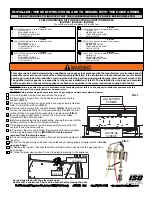
D-8
Rev 2.2, 10/31/94
bulky and expensive arrangement. To eliminate the multiconductor cable, frequently a scheme called
phantom powering is used, whereby the preamp power is carried by the same two wires that carry the
signal. The key to its operation is the fact that the signal is alternating current and the power is direct
current, and they can be separated by the action of a transformer.
The voltage used for phantom powering is usually 48 volts, but it can vary from about 12 to 52 volts.
Microphones which use the lower voltages have a regulator circuit to reduce the higher voltages so no
harm is done when they are plugged into a 48-volt phantom power supply. There is a DIN standard (no.
45-596 ) which specifies in detail the requirements for phantom power. (TAD)
Phantom powering is a compatible system; suitably wired low-impedance microphones may be plugged
directly into a phantom powered input without regard to the presence or absence of phantom power. The
technique gets its name from the old telephone term, "Phantom Circuit," which was a method for creating
a second circuit on an existing pair of telephone wires.
Phasing, phaser
A phaser, or phase shifter, is a device which gives an effect similar to flanging, but with
less depth. It works by shifting the phase of the signal and adding it back to the signal. This causes
partial cancellation at frequencies where the phase shift approaches 180 degrees. Phasing is sometimes
called skying in Britain. (TAD)
See also:
flanging
.
P-Pop
A p-pop (“pee-pop) is the burst of air caused by uttering the letter “P”. Spoken directly into a
single-d
microphone, this blast of air usually causes a loud, audible popping sound. A windscreen of
some sort is a good cure for p-popping as is an omnidirectional microphone. A skilled announcer will
soften the initial attack of the letter, or turn their head slightly so as to avoid the microphone
.
Proximity Effect
Proximity effect is the increase in low-frequency sensitivity of a microphone when the
sound source is close to the microphone. It is a characteristic of directional microphones, and some are
much worse than others.
Proximity effect is a shortcoming, but sometimes it can be used to advantage. If a directional microphone
is placed close to a bass instrument, the low tones will be enhanced, which could be advantageous for
some music. A singer placed close to a directional microphone will sound much "bassier," and
improvement in some voices, I suppose. Some of the early radio "crooners" and radio announcers used
proximity effect to deepen and enrich their voices, and many frequently still do. (TAD)
Q
In reference to a resonant mechanical or electrical circuit or a capacitor, Q stands for "quality
factor." In the case of a resonant system, Q is a measure of the sharpness of the resonant peak in the
frequency response of the system and is inversely proportional to the damping in the system. Equalizers
that contain resonant circuits are rated by their Q value
:
the higher the Q, the higher and more well-
defined the peak in the response. (TAD)
Quantization
The representation of a continuous voltage span by a number of discrete values.
Quantization is inherent in any digital audio system, and it adds quantization error, noise, and distortion
to the signal.
The signal after quantization has a "staircase" shape rather than a continuous curve, and the difference
between this and the original signal is quantization error. The amount of error will always be within one
least-significant-bit (LSB); therefore the smaller the LSB, the better. In quantization of a sine wave,
whose frequency is a submultiple of the sampling frequency, the error will have a definite pattern which
repeats at a frequency of the signal. Thus, it will have a frequency content consisting of multiples of this
frequency, and it can be considered as harmonic distortion rather than noise.
For music, however, the signal is constantly changing, and no such regularity exists. The quantization
error is then wideband noise, and is called quantization noise. Quantization noise is difficult to measure
because it does not exist without a signal. A sine test signal is not good because sometimes this results
in distortion, not noise. If the sinewave frequency is chosen so it is not a submultiple of the sampling
frequency, the quantization errors will be more nearly randomized and will resemble random noise. (TAD)
Ratio
Short for compression ratio or expansion ratio. The term stands for the ratio of the change in the
input signal of a device to the change in the devices output. When graphed on linear-scaled graph paper,
the result is the familiar compression ratio curve (assuming the device is a compressor).
Although the term is most commonly used for compressors and expanders, there is no reason why it
cannot be used for any device that alters its gain in some signal-level dependent manner (i.e. de-essers,
limiters, noise-reducers, etc.).
Содержание 601
Страница 46: ...4 18 Rev 2 2 10 31 94 This page is blank believe it or not ...
Страница 48: ...4 20 Rev 2 2 10 31 94 Notes ...
Страница 50: ...5 2 Rev 2 2 10 31 94 Notes ...
Страница 70: ...7 16 Rev 2 2 10 31 94 Notes ...
Страница 72: ...8 2 Rev 2 2 10 31 94 Notes ...
Страница 74: ...9 2 Rev 2 2 10 31 94 Notes ...
Страница 78: ...11 2 Rev 2 2 10 31 94 Notes ...
Страница 126: ...D 12 Rev 2 2 10 31 94 Notes ...
Страница 138: ...G 8 Rev 2 2 10 31 94 Notes ...
















































